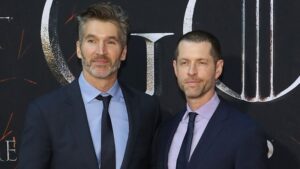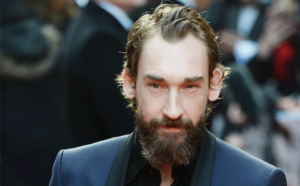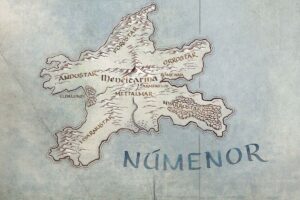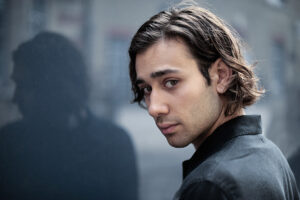This is a departure from my usual posting format in that this is not strictly a news story, but more of a response to a news story. The story, in this case, is actually an interview with Game Of Thrones screenwriters and showrunners David Benioff and D.B. Weiss, which was posted online in Twitter thread form by an attendee, who goes by the username Needle & Pen. The interview was shocking, and soon had the entire internet collectively wringing their hands and crying out to the heavens: “How did this happen?”

Well, by Benioff & Weiss’ own admission, they don’t know – or seem to care. In the interview, which reeks of white privilege, elitism and snobbery, the two men proudly revealed just how inexperienced and unprepared they were for the task of adapting the massive fantasy epic to the small screen, and just how happy they are that they were able to basically dupe HBO into hiring them. For instance, they talked about meeting with A Song Of Ice And Fire author George R.R. Martin for the first time, and confessing to him that they “didn’t really have any” bona fides or experience. In their own words: “We don’t know why he trusted us with his life’s work.”
David is describing the pre-meeting with GRRM who was questioning their bona fides and “we didn’t really have any.” We had never done TV and we didn’t have any. We don’t know why he trusted us with his life’s work.”
— Needle & Pen (@ForArya) October 26, 2019
Now, I’d love to talk about Game Of Thrones, and the various failings of Benioff & Weiss, but that’s not what this post is about – or, well, it is, but only indirectly. This post is, in fact, a response to a response to this interview: soon after that tweet went public, The One Ring.net, the most trusted and reliable Tolkien forum in the world, expressed their concerns that Amazon Prime’s upcoming adaptation of the histories of Middle-earth would fall into the same trap as Game Of Thrones: and they had some legitimate fears, so let’s break down what was said by both sides, and what Amazon can learn from the hugely underwritten, half-baked final season of Game Of Thrones that firmly cemented Benioff & Weiss as some of the fantasy genre’s most hated individuals.
The One Ring.net (or TORN for short) drew attention to the fact that JD Payne and Patrick McKay, the showrunners of Amazon Prime’s Middle-earth series, share many similarities with Benioff & Weiss: both are relative newcomers to the scene, having no experience in TV, or in the making of big-budget, spectacular fantasy epics. Payne and McKay did write a script for a Star Trek movie – but it was never used, which isn’t exactly a promising sign. And, as TORN pointed out rather dismissively, both duos are, when it comes down to it, just “a couple friends”. It’s true that Payne and McKay have been working together for most of their adult lives, just like Benioff & Weiss, but I think it’s worth mentioning that Peter Jackson and Fran Walsh, two-thirds of the creative team behind The Lord Of The Rings trilogy, were a married couple when they started working on the ambitious film project, yet nobody has any complaints about that. The fact that Payne and McKay have a close friendship isn’t really a problem, in my opinion. The fact that they have no prior experience – obviously, that could pose quite a substantial problem along the line. But here are my three reasons why we should NOT be worried about Amazon’s Lord Of The Rings prequel series becoming the next Game Of Thrones-level disaster.
1: They’re Not Alone.
For Benioff & Weiss, being handed full creative control over HBO’s most daunting and daring TV adaptation wasn’t a passion project so much as “expensive film school” – or, in Weiss’ words, a “ten year drunk party”. And the two men treated it as such, giving themselves freedom to make as many mistakes as they wanted. They admit in the interview that working with costume designers, for instance, was a “learning experience”. And yet, rather than bring in talented and experienced individuals to help them figure out the process, Benioff & Weiss went in the completely opposite direction, much to HBO’s chagrin – they decided early on that it was going to be just the two of them, stumbling through the series’ development like idiots, because they “didn’t know better”. They were eventually forced to bring in another writer, Bryan Cogman, and were helped by a second, Dave Hill: both men got to write a whopping four episodes each – out of seventy-three.
On the other hand, Payne and McKay are not alone, and have surrounded themselves with incredibly talented people from all different genres of film and television: their writer’s room is nigh on overcrowded, in fact, with Payne and McKay being joined by Gennifer Hutchison of Breaking Bad, Helen Shang of Hannibal, Jason Cahill of The Sopranos, and Justin Doble of Stranger Things, with Bryan Cogman, Glenise Mullins, and Tolkien scholar Tom Shippey as consultants. It’s a far cry from the two-man show that was Game Of Thrones. There are talented and dedicated people involved with Amazon Prime’s series who can help to guide Payne and McKay on their debut journey. Is that all it takes to steer a five-season epic series with a budget close to a billion dollars? No, probably not. But it’s a good first step, and it will hopefully prevent Payne and McKay from indulging in the amateur excesses that Benioff & Weiss seemed to enjoy in their first few years working on Game Of Thrones.
2: There Is Diversity On Amazon’s Team – Though Not Enough.
One thing that immediately stood out in the Benioff & Weiss interview was their casual dismissals of fans’ complaints of racism, sexism, and especially white privilege – i.e., the idea that white men, even without being blatantly racist, still think they are owed certain privileges and rights by virtue of their skin color. For instance, the privilege to simply walk up to HBO and say “hey, give us a TV show to make”.
I have been thinking about this thread for 12 hours. They are open and… proud of failing upward and being mediocre. It’s frustrating to see what white men get away with while creators of color have to be perfect and prepared always. https://t.co/VccL73GcPw
— roxane gay (@rgay) October 27, 2019
Benioff & Weiss’ counter to the argument was that Dave Hill, whom I previously mentioned wrote a total of four episodes from 2015 to 2019, is of Asian descent. Vanessa Taylor also had a brief stint working with the two men before leaving to write The Shape Of Water. But, is that really enough? In a series that is known for having some of the most iconic female characters in fantasy, is it enough to have only one woman temporarily helping to write those characters? And do I even need to rhetorically ask if it’s enough to have zero people of color in the non-existent Game Of Thrones writer’s room?
“You don’t have any black writers weighing in on how you write Grey Worm and Missandei” “well, we have one Asian writer we promoted up who wrote 3 episodes in the past 3 years”
— The Dragon Demands (@ADragonDemands) October 26, 2019
Now let’s take a look at Amazon Prime’s creative team for their Lord Of The Rings series: leaving aside the fact that Amazon Prime Studios is, in fact, run and overseen by a woman, Jennifer Salke, who was recently named the 17th most influential person in Hollywood, we have, in the Lord Of The Rings writer’s room, a total of three women as of right now: Mullins is also a woman of color, while Shang is of Asian ethnicity.
So, Amazon Prime is doing only marginally better than Game Of Thrones in terms of gender and cultural diversity: but at the very least, there’s some progress being made. We have to hope that more women and POC are added to the writer’s room as time goes on, but for now we can at least be assured that there is already more diversity on this team than on the team assembled for Game Of Thrones.
3: Payne And McKay Have Nowhere To Hide.
Okay, that sounds unintentionally threatening. What I mean is this: when Benioff & Weiss began their tenure on Game Of Thrones, they were doing a relatively simple adaptation from page to screen: and while they did introduce a bunch of new elements, they continued to work from George R.R. Martin’s novels until 2016, when they ran out of source material to draw from: and at that point, most fans tend to agree that the show suddenly began to decline in quality. At first it wasn’t too noticeable, as the fanbase was initially excited to be surprised, and was willing to ignore some of Benioff & Weiss’ mistakes: but by the finale of season 7, it was becoming clear that something was wrong: after years of slow, patient build-up, the storyline of the Night King and the White Walkers was being rushed into the foreground, and Benioff & Weiss were already publicly discussing their desire to conclude the story in its eighth season. The last two seasons were drastically abbreviated to provide for this, with the final season being cut down almost to miniseries format, with only six episodes to tie up several hundred loose ends, story-threads, subplots, so on and so on. And, as everybody is now aware, the final season didn’t go over well: poorly received by critics and fans, the once-mighty TV series ended with a bit of a whimper, reducing complex characters to cardboard cutouts and basically ruining what made the show so much fun: its depth. To nobody’s surprise, though, that depth was a hallmark of Martin’s work, not Benioff & Weiss’.
Payne and McKay don’t have the ability to hide behind J.R.R. Tolkien’s published novels for several years before finally having to strike out on their own, into uncharted territory: because the Amazon Prime series isn’t actually an adaptation of The Lord Of The Rings. It is instead a prequel series, covering the only time-frame in Tolkien’s extensive legendarium that he didn’t write much about – the three-thousand year long era in between the events of The Silmarillion and the downfall of Sauron that is glimpsed in the prologue of Peter Jackson’s The Fellowship Of The Ring. Why do I continue to call the series The Lord Of The Rings, then? Well, there’s still no official title for the show, so it’s going to have to do, despite being a little misleading.
Anyway, it’s encouraging to know that what we see from Payne and McKay will be indicative of the series’ quality going forward, whereas with Benioff & Weiss we were cruelly deceived. The writers at Amazon Prime will have only scraps of material to work from, but it’s their responsibility and duty to fill in the gaping holes in Tolkien’s mythos. Hopefully, they can achieve that – and if they can’t, then we’ll know right away, rather than wasting ten years of our lives.
And finally, a bonus point that I think is worth mentioning: Amazon Prime seems to care for the Tolkien fanbase in a way that Benioff & Weiss never did for Game Of Thrones‘. In the interview, the two men admitted to grossly misinterpreting their own fanbase; in an attempt to make fantasy popular to “NFL players”, they stripped the books of their more fantastical, magical elements – that is, until the final season, when those were the only things left in their dwindling toolbox. They didn’t ever listen to fans’ feedback, because they didn’t see the value of considering other peoples’ reactions. And it’s just as well, because as for their opinions on the books they were meant to be adapting, well…
Did you really sit down and try to boil the elements of the books down? Did you really try to understand it’s major elements.
No. We didn’t. The scope was too big. It was about the scenes we were trying to depict and the show was about power.
— Needle & Pen (@ForArya) October 26, 2019
Now, we don’t know what Payne and McKay think of Tolkien’s work: all we have to go on is the official Amazon Prime press release that says they feel like Frodo on the beginning of his great journey, etc, etc. But Amazon Prime’s Lord Of The Rings has been surprisingly cooperative with and responsive to fans – at least, until their official Twitter account basically went missing in action several months ago. For instance, when fans noted that there were design flaws on one of the Middle-earth maps released by Amazon, the creative team (which we now know is led by renowned artist John Howe) was quick to revise the map. And aside from that one blunder, the other maps they’ve released all hold up to scrutiny, remaining faithful to even some of the obscurest bits of Tolkien canon. And if you’re wondering why I’m rambling about the maps, consider that Benioff & Weiss also acknowledge in their interview that they themselves were “geographically challenged”. So again, Amazon Prime is one step ahead of them in that regard.
So there you have it: my response to the response to this incredibly dismaying interview with the two men responsible for some of the highest highs and the lowest lows in modern television history. If you want to read the full Twitter thread, referenced several times above, I’ll direct you here. I wish you luck.
So what do you think of all this? Do you think Payne and McKay have an advantage, going into this daunting project: or will they end up being the next Benioff & Weiss? And as for Benioff & Weiss themselves – what do you think of their admissions and confessions? Share your thoughts in the comments below!


